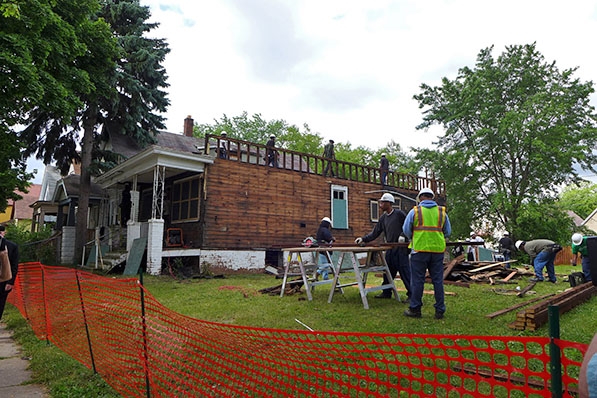City Starts Over on Deconstruction
It's back to demolishing old buildings, while trying to start small deconstruction program.
A year ago the Milwaukee Common Council passed an ordinance requiring a number of vacant and blighted buildings be deconstructed rather than demolished, and yesterday a council committee did away with that ordinance — but with a change that may help revive it.
A substitute ordinance passed by the council’s Zoning, Neighborhoods & Development Committee halted enforcement of the city’s deconstruction rules until 2020. Those rules require buildings built before 1929 to be deconstructed and all the materials salvaged for reuse, as opposed to using the faster, cheaper mechanical demolition.
Ald. Bob Bauman who introduced the deconstruction ordinance a year ago said, “We got into this with the goal of creating jobs and promoting sustainability. Two goals which this city has spent the last decade talking about.” Deconstruction work requires more workers and hours of work for a job that demolition crews do with heavy equipment. This, Bauman and industry advocates said, creates jobs that are prime for entry level workers and ex-offenders.
The success of the program also relied on private contractors making investments in training and infrastructure to support a nascent market for salvaged materials that, in theory, would become lucrative once the supply from city-owned properties juiced that market into existence.
But in the year since the ordinance was adopted, the city failed to secure more than a handful of contracts with private contractors for deconstruction jobs. The Department of Neighborhood Services (DNS) was seeing bids that were significantly higher than they expected, or contractors that could not meet the city’s workforce requirements under the Residents Preference Program and bid applications that were poorly or incompletely filled out.
Bauman is certain that DNS had no intention of ever seeing the program become successful. “DNS has worked its magic by forcing this council to suspend this ordinance that they probably never wanted to see passed in the first place,” he charged.
DNS roundly rejected this claim. “We have been in good faith trying to get this initiative off the ground. We like the council would love to see job creation and diversion of waste, the many good things that deconstruction does,” said Tom Mishefske, DNS interim Commissioner.
In 2018, as properties going without demolition stacked up, they started to become a problem for local residents, specifically in aldermanic districts like the 15th and the 6th where a majority of city owned properties, most of them foreclosures, are located.
Ald. Milele Coggs and Ald. Russell Stamper, of the 6th and 15th respectively, sponsored the new ordinance and a new resolution. The resolution does several things. It directs DPW to resurrect its demolition team, it directs DNS to contract for or staff at least one in-house deconstruction crew by April 1 and train them up with skills, expertise and certification needed using $1.2 million that has been appropriated for this program over the next year.
Coggs and Stamper were not critical of the theory behind deconstruction; rather, they said they were responding to the pressures of blighted, vacant properties, that need to be demolished in their neighborhoods. “It’s about the people we serve so they can have some stability in their neighborhoods,” Coggs said.
Coggs said the new legislation does not eliminate deconstruction, “It merely gives us the opportunity to deal with the reality of where we are.”
Stamper said last year was not a complete failure, adding that the city learned from the results of their deconstruction effort, and developed this new viable ordinance.
But Bauman was able to amend the language of the new resolution to require that DNS uses the $1.2 million to take a meaningful stab at the deconstruction program this year. “That’s a big number,” he tells Urban Milwaukee. “I anticipate they will do 40 to 50 deconstructions this year with that money.”
The downtown alderman expects the amended proposal to pass when it goes before the Common Council and believes the new plan will help assure DNS becomes more committed to deconstruction, even as it goes back to demolishing most buildings. “I think this is a positive outcome,” Bauman says.
If you think stories like this are important, become a member of Urban Milwaukee and help support real, independent journalism. Plus you get some cool added benefits.
More about the Deconstruction Ordinance
- Bauman Wins Preservation Funding By Sacrificing Deconstruction Funds - Jeramey Jannene - Feb 7th, 2025
- Amendment Would Shift Money From Demolishing Homes To Fixing Them - Jeramey Jannene - Oct 23rd, 2024
- Tentative Deal Would Salvage Milwaukee’s Deconstruction Program - Jeramey Jannene - Oct 25th, 2023
- Eyes on Milwaukee: Deconstruction Ordinance Again Suspended - Jeramey Jannene - Mar 17th, 2023
- Eyes on Milwaukee: Deconstruction Program Suspended Again - Jeramey Jannene - Feb 14th, 2022
- Eyes on Milwaukee: Deconstruction Policy Remains, Well… Deconstructed - Jeramey Jannene - Dec 13th, 2021
- Eyes on Milwaukee: New Deconstruction Firm Makes Progress - Jeramey Jannene - Feb 2nd, 2021
- Eyes on Milwaukee: City Hires New Deconstruction Contractor - Jeramey Jannene - Oct 12th, 2020
- Eyes on Milwaukee: City Moves to Fire Deconstruction Firm - Jeramey Jannene - Mar 2nd, 2020
- Eyes on Milwaukee: Deconstruction Contractor Delaying Work - Jeramey Jannene - Jan 27th, 2020
Read more about Deconstruction Ordinance here





















I would hope getting the deconstruction program under way will lower the barriers to its growth – that is the kind of growth we need – and begin to counter the demolition over time.